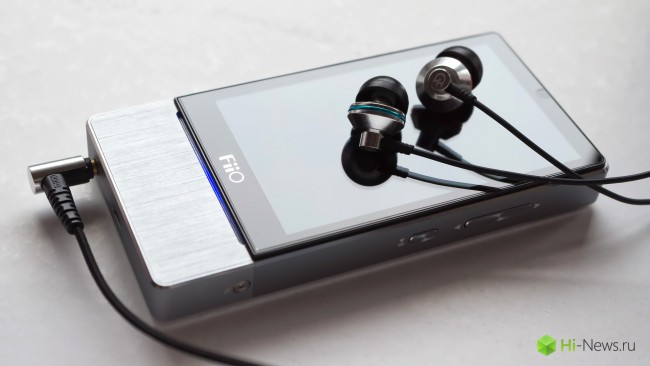
The event, which was awaited for more than a year. An event that will change the world of audio. The event, which you cannot pass all lovers of quality sound. Sorry for pathos, but otherwise it will not work, Fiio has unveiled its long-awaited flagship X7, which is not yet the best sound (though close), but guaranteed to be the most successful in sales. Now I will tell you why.
Rumors about the flagship Fiio walked for a long time. The company is actively fueled them, periodically outputting a 3D render of the next concept, strictly the measured portion of rumors. To fall the device emerged entirely: ESS9018 DAC in the role of Android as an OS replacement modules amplifier. The latter is actually and will be a driving force for the success of the Fiio X7, the company rightly decided that freedom is better than its absence, and invited all interested (and able) to do these same modules. For this Fiio will provide all specifications, ranging from description interface slot and to physical size of the Board. In addition, developers will be able to buy a ready-made chassis for modules, and after passage of simple procedure of certification — even sell their creations through a network of distributors Fiio. This step is very similar to the approach Apple, Chinese, and Cupertino, build a symbiotic relationship with the developers. These developers get a new big market and advertising and marketing support, in return they increase the value of the flagship product-locomotive, offering additional scripts of its use.
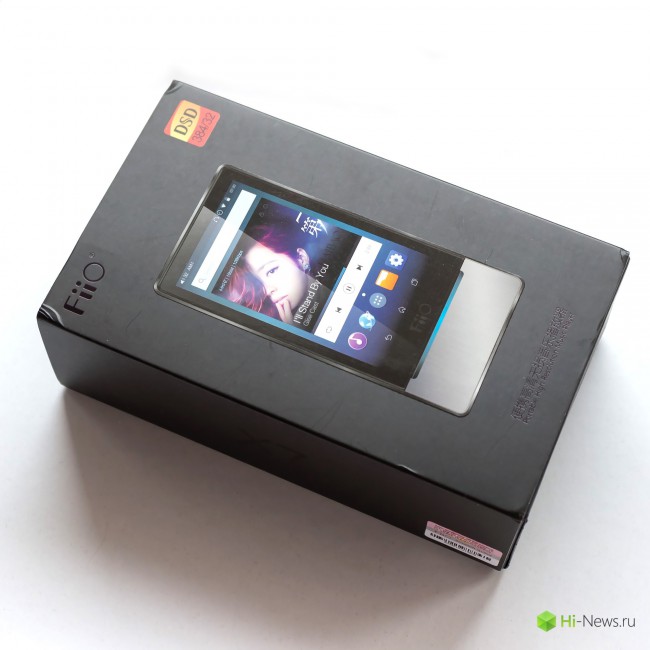
Fiio X7 has started to ship to distributors in time for the Christmas sales season, so early next year we will obviously see a lot of solutions.
Another reasonable step is the use of Android as the operating system, as well as equipping devices Wi-Fi modules and Bluetooth. It provides access to online streaming services and DLNA/UPnP, and allows you to use not only wireless headphones, but portable (and not) column.
Of course, the Android OS in the role demanded serious enough by the standards of a players iron. In addition, cool aluminum casing, high-end DAC with a high quality connection and very good screen also contributed to the price of the device. However Fiio decided not to cheat the price tag and made the cost of the X7 is very good relative to competitors. MSRP in USA is $ 650, in Russia you can pre-order 45 600 rubles (the price at the time of writing, the future may change due to exchange rate instability).
How it shows itself in operation?
Specifications
Common
- CPU: RK3188 @ 1.4 GHz, 4 cores
- OS: Modified Android 4.4.4
- DAC: ES9018S
- Wi-Fi: 802.11 b/g/n
- Bluetooth: V4.0 + EDR
- The screen at 3.97″ IPS TFT, multi-touch (up to 5 touches at once)
- Resolution: 480 × 800 (233 ppi), 16.7 million colors
- Viewing angles: 178°
- Sensors: light, accelerometer
- RAM: 1 GB
- ROM: 32 GB (available for user about 27 GB)
- Memory card: MicroSD up to 128 GB
- Battery: 3500 mAh
- Working time on single charge: up to 9 hours (with IEM amp and headphones at 32Ω)
- Charging time: <4.5 h when using a 2A charger
- Housing material: aluminum
- Dimensions: 130 mm × 64 mm × 16,6 mm
- Weight: 220 g
- Supported formats DSD: DSD64/DSD128 (“iso”, “dsf”, “dff”), DXD: 352.8 K
- Lossless formats supported: APE to 384/24, APE Extra High up to 192/24, 48/24 to Insane APE, ALAC up to 384/24, 384/24 to AIFF, FLAC to 384/24, 384/64 to WAV, WMA to LOSSLESS 96/24
- Lossy formats supported: MP2, MP3, AAC, ALAC, WMA, OGG
The parameters of the linear output
- Total harmonic distortion + noise: <0,0007% (or 10KΩ, 1 kHz)
- Frequency range: 20 Hz – 20 kHz
- Channel separation: >100 dB (10KΩ, 1 kHz)
- The ratio signal/noise ratio: ≥115dB
- Signal level: >1,4 Vrms (10KΩ, 1 kHz)
Settings IEM amplifier
- Power output (@ 1 kHz): 200 mW @ 16Ω, 100 mW @ 32Ω, 10 mW @ 300Ω
- Frequency range: 20 Hz – 20 kHz
- The ratio signal/noise ratio: ≥115dB
- Output impedance: <0,2 Ω
- Channel separation: >73 dB (32Ω, 1 kHz)
- Total harmonic distortion + noise: <0,0008% (32Ω, 1 kHz)
- Peak output voltage: >the 5.2 Vp-p
- Maximum output current (approximately): >250 mA
Packaging and delivery package
In the design of the box Fiio decided to do without unnecessary frills. No boxes of wood, covered with skin no boxes. Ordinary black cardboard, cover the same black color, everything is simple and restrained. The box has the traditional scratch-off sticker with a code to verify the device’s authenticity.
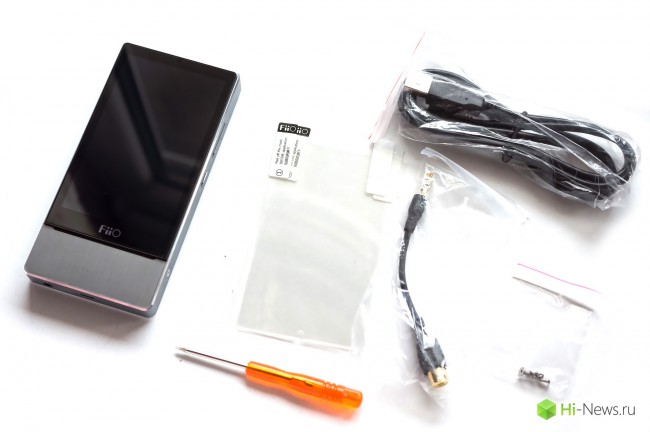
Inside the box you’ll find the player itself, and underneath the accessories. Included with the X7 put:
- MicroUSB cable
- Adapter for coaxial output
- Protective film for screen (the one already glued from the factory)
- A screwdriver to change the amplifier modules
- Spare screws of fastening of the amplifier module
Very touched by the concern Fiio, as they always have tried to anticipate that the user may lose or mess up, and put in a set of “spare tire”. It is a pity that in the complete set there is no cover, I thought it would not hurt. I think the company simply did not have time to do something sensible, and soon the covers will appear with considerable probability will be added into the package.
By the way, already appeared accessories, for $ 8 in the official store on Fiio AliExpress you can buy a set of stickers for customization of the player and a 10 — tempered safety glass on the screen.
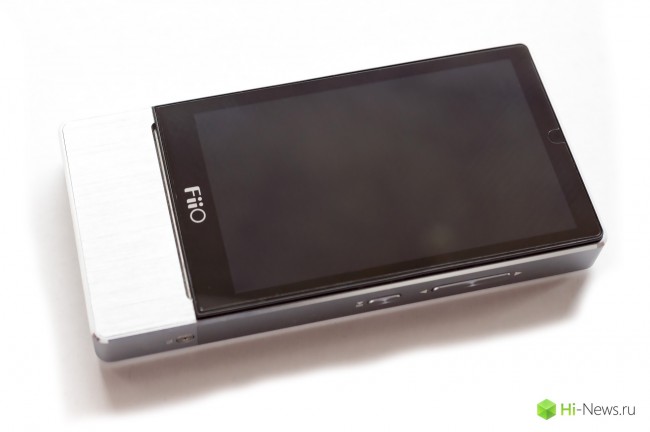
Design and management
Appearance is one of the strongest sides. Of course, the X7 is quite large, but when you realize how much hidden inside him, aware of the fact that it is much less than it could be. “Seven” is teetering on the edge, when the discharge device from the pocket goes in the category of bricks, not moving it. The case is made of durable aluminum, perfectly fits in your hand and, thanks to the balance weight, do not strive to slip out.
The main control touch screen acts, the company is clearly not greedy with its quality and used very decent module that is not ashamed to be a mainstream phone. The screen has beautiful colors, good color reproduction and decent viewing angles. It even remains readable in the sun (although not as good as we would like). Working steadily and the sensor, in the past left a terrible resistive screens, here we have a capacitive sensor and even has support for multitouch (nowhere, however, is not used). The screen is slightly elevated above the level of the front panel, so in case of a fall the device will clearly feel the impact with all the attendant dire consequences. While Fiio (and other manufacturers) not released covers, I recommend at least stick to the protective glass. 100% guarantee it will not, but sometimes to protect can.
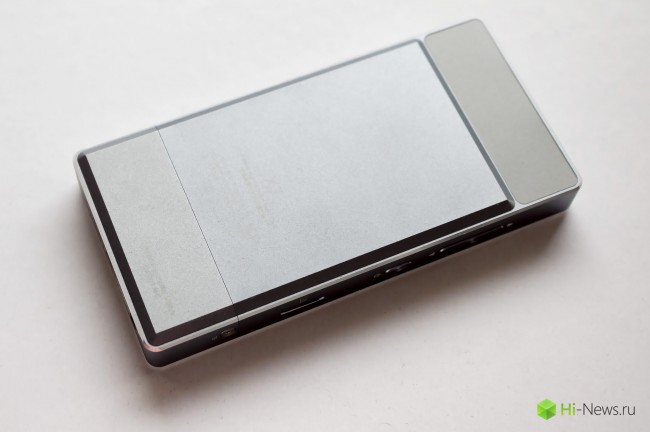
Under the screen there is a strip of led lights to indicate different modes of operation of the player. Fortunately, the latest version of firmware has an opportunity to configure or completely disable.
The adornment of the touchscreen do not forget about the control buttons. The player received two sets of symmetrical buttons on both sides of the device. Each of these buttons consists of a “rocker” and a single button. Kachelki serve to adjust the volume and navigate tracks, single button to turn the monitor off and power, as well as play/pause. The function of the buttons (except off) can be changed in the settings. This care allows to control the player without looking at the screen. On the left side additionally, there was a place for MicroSD slot.
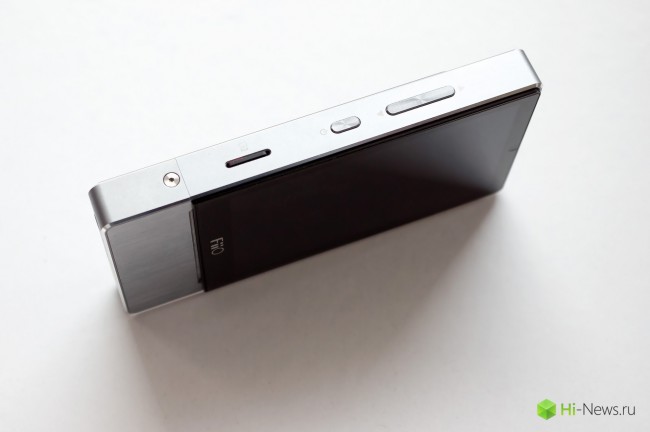
Interface connectors are placed at the top (line out, combined with coaxial) and bottom (headphone and MicroUSB). Headphone output depends on the amplifier module in the current version it is the usual 3.5 mm TRRS that support control via headset, other amps, may have other connectors (at least the balanced module will be exact). MicroUSB is used for charging, access the MicroSD card and its own memory device, and to connect to a docking station, which will be the recently-announced desktop amplifier Fiio K5. In the near future, the player will gain more function USB-DAC, so that the task of the USB connector is added to another.
It is already obvious that in the not too distant future, Fiio will present the other docking station in addition to K5 — as compatible connectors now has all the modern ruler of their players. The first renderings were shown at Head-Fi.
The bottom shell of the removable device, there is the amplifier module. To replace it you need to loosen two screws on opposite ends. This design differs from the solution of HiFiMan in which to change the amplifier had to go as much under the battery.
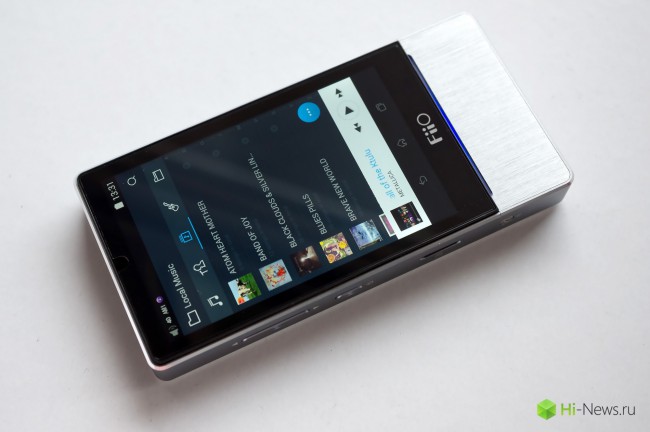
The rear panel is devoid of any functional load, in its upper part there is a small bevel and plastic insert, which hides the antennas of wireless modules. In the lower part of the model information and serial number.
Of course, the entire device is at the highest level, without the slightest flaws of the build, no squeaks, backlash or hints at hanging out. Everything is as it should be the flagship model.
All this, of course, must be accompanied BY quality. In Fiio decided to rely on a fairly old version of Android 4.4.4, which re-worked for audioid. I would like fresher OS, but I doubt that it will happen, too much work has been done “under the hood”. In the firmware there are no default services Google and Google Play, although the install programs from the APK file in the company was allowed. I think in the future the services will still be screwed, although not sure it will be an official firmware.
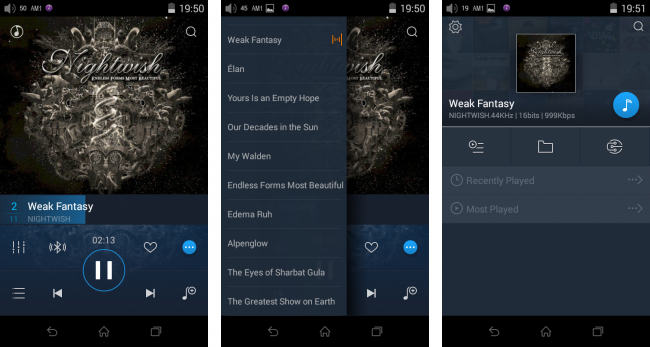
Remarkable feature of firmware X7 is that it has a so-called “pure music”mode. When activated, after loading the device immediately launches brand Fiio player, and you don’t have to worry about the presence of Android on the device. If you, unlike me, love the Android OS, you can use the full mode with the launcher, third-party applications and everything else. In this case, the player will be a normal application.
Actually, it is the player and the X7. On its creation the company worked hard, it has everything that you can think of. The creation of a media library, custom search, browse by artists, albums, and genres, creating and managing playlists. Even deleting files it’s. All the control system is reasonable and convenient, it’s easy to understand and start using. In addition, the player is able to bypass the built-in Android mixer and resampler and works directly with the DAC, which also has a positive effect on sound quality.
The player has two interesting features that I have not immediately found. Swipe from the left edge to the center opens the current list of tracks, allowing you to select and swipe from the right edge allows you to adjust the volume.
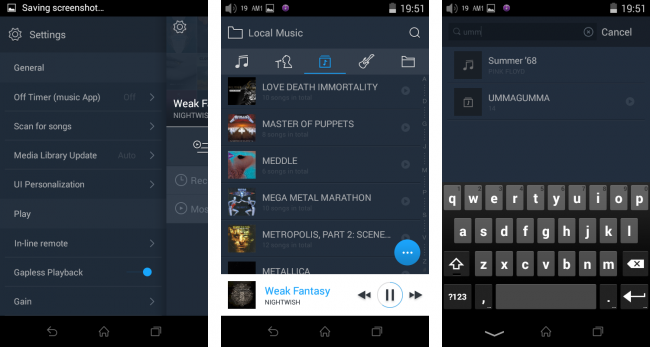
In the first versions of the firmware, the player freezes for a while when switched on, but with this problem actively competing in the new versions.
Of course, the firmware in the player offers certain features that can adjust sound. Channel balance can be adjusted ±10 dB, the volume is controlled by analog circuits with digital control and has 120 steps. There was a place for 10-band equalizer on the touch screen to configure it especially comfortable, although I still believe that because of the negative effects on the sound it is better not to use.
Firmware version 1.3, with which the player will initially be supplied on sale, provides for the update “over the air”, which significantly simplify further maintenance of the device. It is already known that the next updates will be dedicated to the functions of the USB DAC and to improve stability.
Time all close enough to the stated, when turned off wireless modules in the “Pure Music” with the Oppo PM-3 at 44/16 FLAC player played 8 hours and 45 minutes. Charged it for 4 hours and 20 minutes. Naturally, the active use of the player interface will significantly reduce the time, but still it’s just a great indicator.
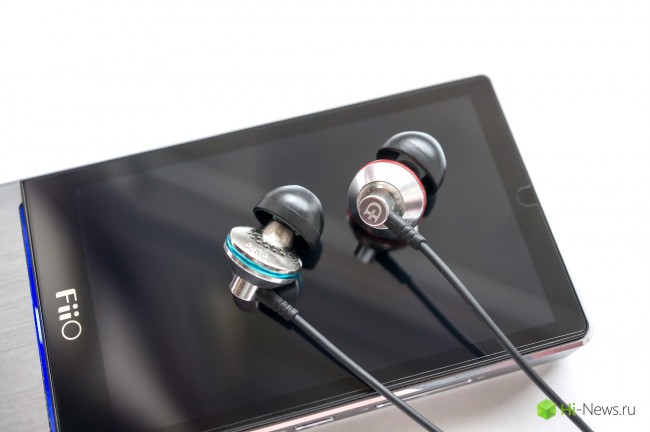
The sound
To listen to the player we used the following headphones:
- HiFiMan Re600
- ZMF Omni
- Oppo PM-3
- Dunu DN-2000J, Titan 1, Titan 3 and Titan 5
- Lear LHF-AE1d
- Ambient Acoustics AM10
It just so happened that X7 was the most “weak” of all proposed amplifiers. IEM module is not power even against younger models Fiio leaving space for future upgrades. At least the company promises another balanced amp module for full size headphones with the increased power. According to rumors, the balanced amplifier can even get a new OPA1622 from Texas Instruments.
Meantime, it is worth considering that the current modification of the X7 is “worst” for the sound option, and in the future we can expect an even greater increase in sound quality. At the moment, the flow player can be described as light coloured, very detailed, very technical, with an emphasis in monitormost sound. There is a small tint of academic showtest that sometimes is perceived as “easy”, the player is not trying to embellish the sound, or soften it somehow to paint. After more extended listening, it becomes clear that actually it is not easy, and it is the absence of gag.
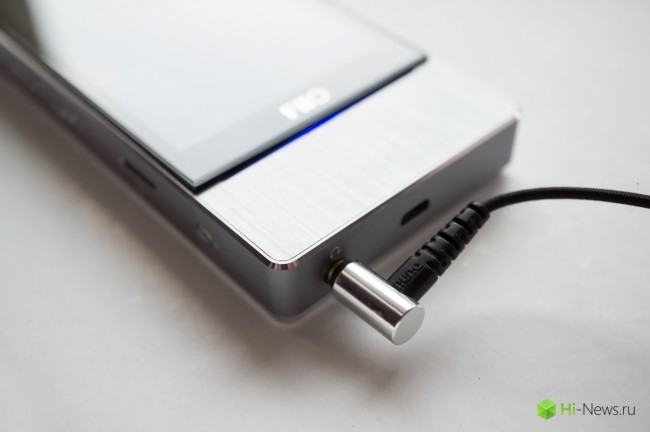
For the test I connected the X7 to my Fiio E12DIY, making sure that the main restrictions in the sound caused by the amplifier and with good reinforcement the player will reach even greater.
The bass player has a dry, quick and quite accented. Naturally, well captured the texture of bass and nuances of instruments that fall in this range, but with bassy headphones there is a risk of overabundance of bass. Steep and powerful kicks in the bass is good, but when the bass barrel volutives in the brain without mercy, this is exhausting. Fortunately, earphones without the excess bass a lot now, and you can just enjoy quality bass.
MIDs — absolutely no complaints. Here Sabre traditionally shows itself from the best side, passing all the minutest details available on record. This leads to incredible criticality in the choice of material, but this is clearly not a shortcoming of the device. Emotions, volume — all of this can X7. Scene is very wide, drawing in depth allows you to easily track different plans complex compositions. The main problem of player in that he adds nothing on MF from himself, so dry and boring records will be as bored with him to sound. This is the price you pay for neutrality.
The RF — part of the range, which will cause a maximum of the dispute over a player in the future. This range is supplied without any smoothing, and attempts to get him on the second plan, in combination with a slight simplification treble on some headphones it gives the “sharpness”, which some fear like the plague. So if you RF-FOB, it is best to look for another player, by choosing the model with reduced HF. For other people X7 will sound quite airy and easy, with an appropriate number of polituchiy.
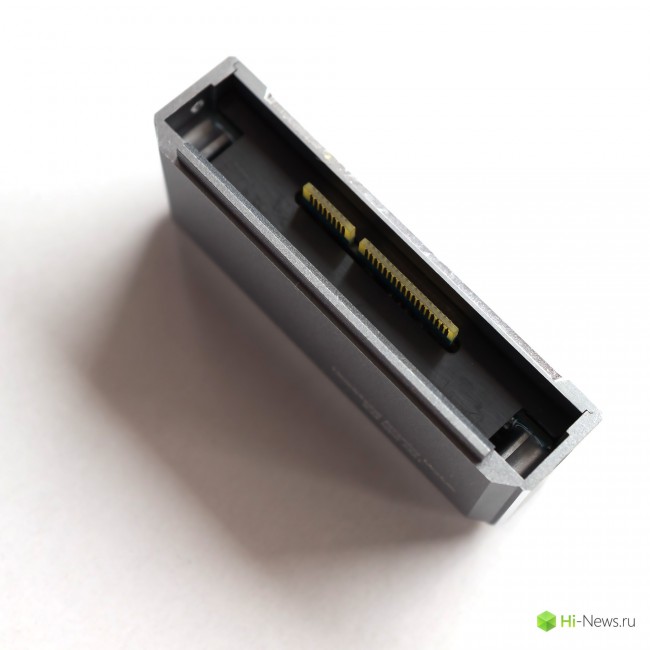
In General, the shortcomings in the sound of the X7. But first, he still plays more than good, and secondly, it is worth remembering about replacement amps in them lies the main secret of the success of X7.
Of course, it is impossible to do here without comparisons.
L&P L5 Pro. Suddenly bursting on the Olympus hi-end players, Pro L5 is in many ways the antithesis of X7. Slightly softened, smoother, more velvety sound. This is an interesting option for those who want to buy a player “once and forever” and has no plans to do replacement amplifiers, firmware and other vanity.
Questyle QP1R. Another rising star in the world of Hi-End. Unlike other solutions, the current amplifier, which is the pride of the Questyle, allows this player to show excellent synergy with many headphones. I QP1R more detailed treble, although the bass, to my ears, slightly lacks texturely. Unfortunately, QP1R ruining terrible ergonomics, so I advise you to hold in your hand before buying.
Cayin N6. My favorite in the category “upper middle” segment. Player different musicality that is given to him the expense of a small loss of resolution, and therein lies its main difference from the X7. Last better resolution and much impartial on the pitch.
Fiio X5-2. The former flagship of the company will now move to the middle segment, freeing the upper models in the line. However, the second revision of the X5 remains very relevant by offering the user less detailed sound and less bass depth, but given the price and should be expected. In addition, the owners of a large music library will appreciate the presence of two memory slots.
iBasso DX90. The iBasso now there is no flagship. Coming DX200 aims to become the main rival X7 is not released yet, DX80 — clearly a middle level, DX100 is long outdated, and new to find it is not real. So the only thing that can oppose X7 from iBasso, this DX90, which is also discontinued, but still sells a lot. DX90 is not up to X7 on naturalness and volume, while HF he has drawn a little better.
HiFiMan HM-901 Balanced. Another “opposite” X7, albeit in the other direction. 901 th — player, energetic, with a very energetic flow. X7 from him are severe so that it seems an Opera singer in the background of a punk rocker.
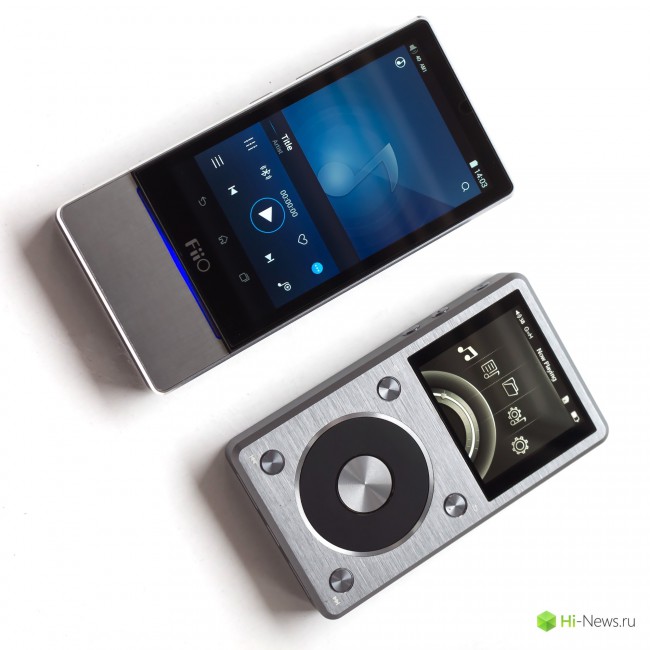
Compatibility
In the current version X7 the buyer will have to spend some time on the selection of headphones. Because X7 does not offer nearly no gag, the headphones will be the determining element in the sound. In addition, the selection of headphones should be avoided models with a strong emphasis on bass or treble, not to get “overload”. The power reserve of a player not phenomenal, so tight headphones wouldn’t fit him, in the future, new amplifiers will fix it, but now we have to consider this fact. I just need my X7 is connected to Fiio E12DIY.
Traditionally, a good player showed Dunu Titan 1 (but not 3 and 5), Lear AE-1d, the Rock Jaw Alfa Genus v2, headphones Audio Trinity Engendering. From the miscellaneous models sounded very good with him Oppo PM-3. For izodinam in the face of ZMF Omni player not enough power (E12 then came to help).
Genre player, of course, universal, but it is worth considering his picky material, old records with poor mastering it is clearly contraindicated.
Traditionally, several tracks examples.
Annihilator — Ritual. Talking about “smart trash” — implied Annihilator. On the album “Waking the Fury” Jeff decided to show that, unlike the colleagues, even at exorbitant rates he is able to deliver original tunes and catchy riffs. Ritual — fast, angry and catchy track from this album. Naturally, in order to play him properly, we need the same quick player, and X7 copes with this task.
Ozric Tentacles — Oolong Oolong. After this group, the genre of space rock should cease to exist, still no one to already created these add Brits can’t. Complex, multi-faceted melodies reminiscent of a box full of precious stones, constantly changing its color, and playing with reflections. They want pereslushivat over and over again, discovering something that last time had not noticed. Here X7 to its dimensional scene and sharing the plans also show yourself perfectly.
Arena — Tears In The Rain. One of the most revered albums in the works by the classics of neo-prog is really challenging for players material. Excellent keyboard solos are complemented Nolan Mitchell guitar work and very tight percussion Poynter, giving together a very diverse and versatile tracks. Of all the bands playing in this complicated genre, Arena is probably the most strict and not allowing myself any “frills”: a squeaky clean sound, complex melodies, and pure vocals. Needless to say, that here X7 shows its strengths, enabling you to enjoy every tiny nuance of sound?
Conclusions
In General, the story is repeated again and again: Fiio made a player that offers a lot of interesting features, not available from competitors, and offer him for a very fair price. Traditionally, a player will be praised on Western sites and forums and berate on our own, but this does not prevent him to take a leadership position in sales. Of course, the X7 came out perfect device immediately stopped all for a belt, it has drawbacks, especially noticeable considering the large sum of money, but it has unique advantages that more than outweigh any disadvantages.
